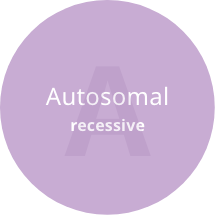Genes are carried inside your cells on tiny structures called chromosomes. They act as a set of instructions telling your cells how to function. Typically, human cells contain 23 pairs of chromosomes, or a total of 46 chromosomes. Genes are involved in determining different physical traits, such as height and hair color, but they also play a key role in various health conditions. Some conditions are inherited, meaning they are passed down in a family from one generation to the next.
The earlier you learn that you are at risk for a genetic condition, the sooner you can discuss appropriate medical management with your healthcare providers and develop a support network of people close to you.
Some inherited diseases are common; some are rare
Changes in genes are commonly called genetic variants. Some genetic variants can cause health conditions when they do not allow the gene to function properly.
Patterns of disease inheritance: Individuals may be at different levels of risk based on how the variant runs in a family.
Disease inheritance patterns include:
A disorder that occurs when a variant in 1 copy of a gene* causes the disease. Multiple individuals across generations can be affected.
Examples:
Autosomal dominant polycystic kidney disease (ADPKD), Marfan syndrome
A disorder that occurs when variants in 2 copies of a gene* cause the disease (1 variant inherited from each parent). More commonly seen in individuals of the same generation, such as siblings.
Examples:
Gaucher disease, Pompe disease, Mucopolysaccharidosis type I (MPS I)
*Every person has 2 copies of a gene, 1 inherited from each parent.
X-linked dominant disorders affect males and females differently. Conditions that are passed on in this manner typically affect more females than males.
Examples:
Rett syndrome, incontinentia pigmenti
X-linked recessive disorders affect males and females differently. Conditions that are passed on in this manner typically affect more males than females.
Examples:
Hemophilia A, red-green color blindness
A disorder that occurs when there is a variant in the DNA inside the mitochondria, the tiny structures within the cell that produce energy and help the body to function.
Examples:
Kearns-Sayre Syndrome (KSS)* Leber hereditary optic neuropathy (LHON)
*KSS can be the result of a new spontaneous change of mitochondrial DNA as well.
A disorder that results from a combination and/or interaction of both genetic and environmental factors.
Examples:
Diabetes, osteoporosis
Common, multifactorial, hereditary conditions include:
- Alzheimer’s disease
- Arthritis
- Cancer
- Diabetes
- Heart disease
- High blood pressure
- Obesity
Some less common, single-gene diseases are:
- Autosomal dominant polycystic kidney disease (ADPKD)
- Acid sphingomyelinase deficiency (ASMD)
- Cystic fibrosis (CF)
- Fabry disease
- Gaucher disease
- GBA-Parkinson’s disease (GBA-PD)
- Hemophilia
- Huntington’s disease (HD)
- Marfan syndrome
- Mucopolysaccharidosis type I (MPS I)
- Pompe disease
GBA=glucocerebrosidase.

Your ethnicity alone can make you more likely to have certain genetic conditions.
For example, if you’re of Ashkenazi Jewish ancestry, your risk for Gaucher disease is about 1 in 850. If you’re African American, your risk for developing sickle cell disease is about 1 in 365.














